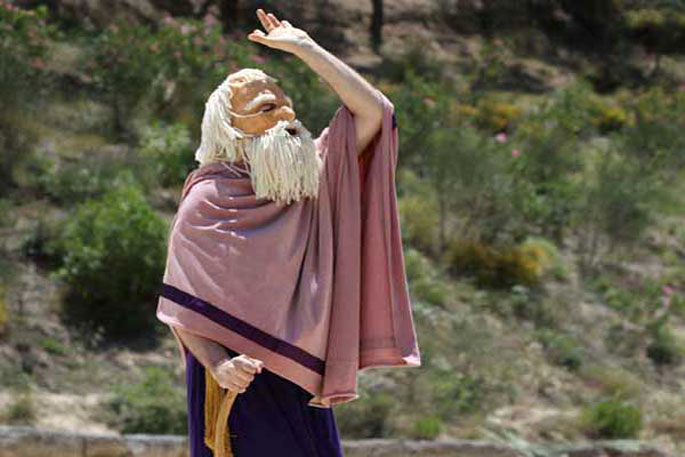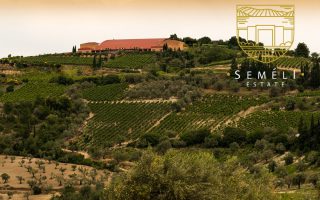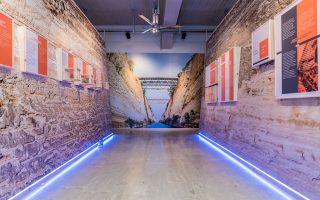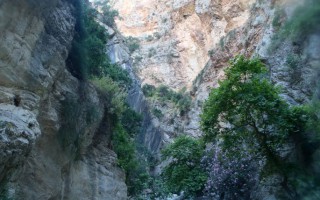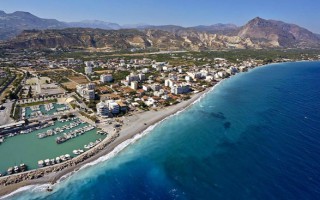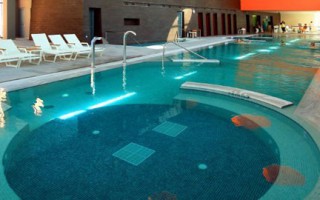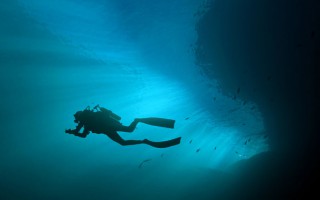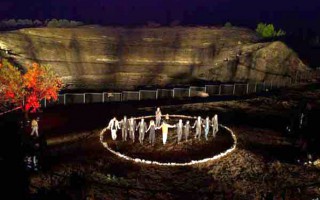The ancient Greeks celebrated festivals at Nemea that were part of the cycle of games at Delphi, Isthmia, and (best known today) Olympia. At each one of these four sites in rotation, for a brief period each year, wars and hostilities were suspended by a sacred truce, and all Greeks – Spartans and Athenians, Corinthians and Argives, Macedonians, and Cretans – gathered in recognition of their common humanity. The society for the Revival for the Nemean Games (which now has more than 1900 members from around the world) was founded in the belief that there is today scope and perhaps even the need for the average person – regardless of ethnicity, language, religion, gender, age, or athletic ability – to participate in an international athletic festival.
And so it happened in 1996 and 2000 and 2004 and 2008. More than 2500 people from 45 different countries, ranging in age from 6 to 96, have added their footprints to those of ages long gone. The games include running in the Stadium and a long distance run called “Footsteps of Herakles”. No records are kept, no medals are awarded. Families with picnics on the slopes of the stadium are as much a part of the festival as the runners. Races are organized by gender and age, and are interspersed with music and dances.
The Society for the Revival of the Nemean Games was founded on December 30, 1994, but the idea of a revival began much, much earlier. After continuous efforts there came the completion of the excavations and the publication of the stadium, and its landscaping. On July 6, 1994, Miller turned the stadium park over to the State in the persona of the then Minister of Culture, Thanos Mikroutsikos. It was wonderful to see the ancient stadium come back to life after so many centuries in front of 1500 spectators. The Nemean Games have 2 basic principles the Games should be as authentic, as true to historic precedent, as possible; and they should be for the participation of everyone to become an ancient Greek athlete if only for ten minutes.
In antiquity athletes assembled at the altar in front of the Temple of Zeus where they performed sacrifices and swore their oath. All the athletes assemble at the ancient locker room (apodyterion) where they will be assigned to their final grouping of twelve for each race – each group of similar age and the same gender.
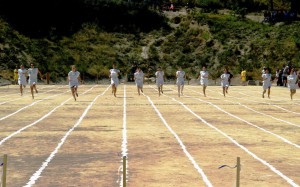 Once inside the tent, the athlete will small clay jars (aryballoi) which contain olive oil as they did in antiquity — for the athletes to rub over their bodies.The modern participant at the Nemean is not required to use the oil, nor to compete in the nude – although that would be authentic. Rather, when each competitor enters the apodyterion tent, he or she is given a large plastic box, a chiton (tunic), and a zoni (belt). A doulos (slave – in a yellow chiton) will take the box for safe-keeping. The chiton slips over the head, and the zoni tightened around the waist will allow the length of the chiton to be adjusted to suit.
Once inside the tent, the athlete will small clay jars (aryballoi) which contain olive oil as they did in antiquity — for the athletes to rub over their bodies.The modern participant at the Nemean is not required to use the oil, nor to compete in the nude – although that would be authentic. Rather, when each competitor enters the apodyterion tent, he or she is given a large plastic box, a chiton (tunic), and a zoni (belt). A doulos (slave – in a yellow chiton) will take the box for safe-keeping. The chiton slips over the head, and the zoni tightened around the waist will allow the length of the chiton to be adjusted to suit.
A Hellanodikes (judge) enters the tent when it is time for the next group of runners. He will be dressed in a black himation (long robe) as were the judges at the ancient Nemean Games in memory of the death of Opheltes, and he will be holding a switch of olive with which he will flog anyone who commits a foul or does not obey his orders — as was done in ancient Greece. The Hellanodikes summons the next group to leave the apodyterion and enter the passageway between it and the krypte esodos (hidden entrance tunnel). There he administers the oath of the Nemean Games in Greek: “Do you swear to abide by the rules of the Nemean Games and to do nothing that would bring shame to you, your family, or the spirit of the ancient Games?”
Each participant is expected to respond: “I swear.” And the judge will respond, as he did in antiquity: “Now go forward into the stadium, and be worthy of victory.”Now the participant passes through the 120′ long ancient tunnel (constructed about 2,320 years ago) being careful not to touch the walls, for the graffiti scratched then by ancient athletes can be damaged. At the far end of the tunnel, the participants wait for a blast from the salpinktes (trumpeter, dressed in a maroon chlamys) that signals the crowd to be quiet. Next the keryx (herald, in a blue himation) calls out the name of each athlete.
When the keryx calls his or her name, the participant runs out of the tunnel to the track where another hellanodikes asks each participant to draw a kleros (marble lot) from a bronze helmet. This is the race called the stadion although the ancient stadion race was actually twice as long, but the Nemean stadium track is not preserved to the full ancient length.
With the lanes assigned, each modern athlete positions him-/herself with the toes of one foot in the front groove and the toes of the other foot in the back groove. It does not matter which foot is forward and which behind, but BOTH FEET MUST BE IN THE GROOVES. If both feet are not in the grooves the switch of the Hellanodikes will be felt.
When all the runners have taken their positions, and the aphetes (starter, in a white himation) has prepared the hysplex to his satisfaction, the salpinktes will blow his trumpet, and the aphetes will shout out three ancient words which are the rough equivalent of our English “ready! set! GO!”
“poda para poda” (foot by foot)
“ettime” (ready)
“ápite” (GO)
As he shouts ÁPITE the aphetes pulls the trip-cords which release the hysplex and the torsion-loaded post hurls the barrier-cords to the ground in front of the runners.
The Hellanodikai at the finish line tie a ribbon around the head of the victor, and give him/her a palm branch. These were the immediate tokens of victory that were awarded in antiquity. The salpinktes will blow his trumpet, and the keryx will announce the name of the victor. (The winner should wear the ribbon and keep the palm branch close at hand for the rest of the Games.)
The first of the twelve Labors of Herakles was to slay the Nemean Lion, a beast whose skin could not be penetrated. Herakles was forced to wrestle the Lion and strangle him. Ancient authors tell that Herakles had his base of operations against the Nemean Lion at Kleonai. The modern race which follows the road from Kleonai to Nemea — as did Herakles — is therefore called “The Footsteps of Herakles”. The course of the 7.5 km. race is marked clearly by a Hellanodikes and a doulos at each cross road. It begins from the Temple of Herakles and follows a country road through fields of grain, olive groves, and vineyards. The gradual uphill course becomes much steeper as the road enters and passes through the modern village of Kleonai with Akrokorinthos in the background.
After the last of the Footsteps of Herakles runners crosses the finish line, the participants return to the apodyterion to clean up and dress.
Late that afternoon come the closing ceremonies. The winners, with their ribbons and palm branches, assemble in the apodyterion. All the other participants, clad in their T-shirts, assemble at the north end of the track in front of the Altar of Zeus and then file past the Hellanodikaion to receive a “Nemea” pin. This pin is not only the official badge of participation at the Games, but is also the “ticket” to the banquet that will follow for those who ran in the Nemean Games. Meanwhile the winners will be ordered in accordance with the sequence of races in the krypte esodos. When the keryx calls each name, he or she will come forward to the Hellanodikaion (judges’ stand) to receive the official ancient victory prize — the crown of wild celery.
With all the participants on the ancient track, the final ceremonies of the modern Nemean Games end with a prayer to Nemean Earth and the extinguishing of the flame on the Altar.
In antiquity, the final item on the program of the Olympic games was a victory banquet in the prytaneion (town hall) next to the eternal flame of the goddess Hestia. The equivalent of this at the revived Nemean Games is a banquet in the square by the Town Hall of Ancient Nemea where the office of the Society for the Revival of the Nemean Games is located. Those who have run, and their friends and families, will be hosted by the Society and by the citizens of Ancient Nemea. The evening frequently ends with dancing in the streets.
All the participants ran barefoot and in ancient tunics which they put on in the ancient locker room. Your real medal; feet sore from contact with the same earth where ancient feet ran more than 2,300 years ago – and the knowledge that they had been in direct physical contact with an ancient idea, an ancient spirit, that still lives at the earth of Nemea.
Source: www.mythicalpeloponnese.gr

